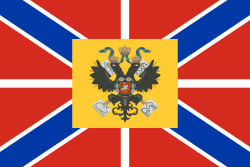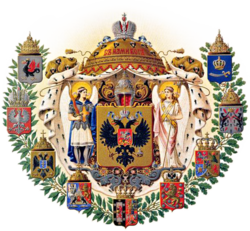Tsarevich of Russia
The title of Tsarevich of Russia[a] was traditionally used by the heir apparent or heir presumptive in the Russian Empire. The title was used with the style Imperial Highness. The title was usually only used by males due to females being prevented from succeeding the throne after Catherine the Great.
Usage
It is often confused with "tsarevich", which is the title for any son of a tsar.[1] Normally, there was only one tsesarevich at a time (an exception was Grand Duke Constantine Pavlovich, who was accorded the title until death, even though law gave it to his nephew), and the title was used exclusively in Russia.
The title came to be used together with the formal style "successor" (Naslednik), as in "His Imperial Highness the Successor Tsesarevich and Grand Duke". The wife of the Tsesarevich was the Tsesarevna.[2]
Examples
- His Imperial Highness Tsarevich Alexei Nikolaevich of Russia, Grand Duke of Russia. He used the title all his life. He never succeeded his father and was murdered in 1917.
- His Imperial Highness Tsarevich Nicholas. He used the title from 1868 till the death of his father in 1894. The future Nicholas II of Russia. He was the last Russian Tsar.
- Tsarevich Alexei Petrovich of Russia, son and heir of Peter the Great who never succeeded.
Related pages
Notes
- ↑ Sometimes written in other languages as Cesarevich or Caesarevich
References
- ↑ Macedonsky, Dimitry (June 2005). "Hail, Son of Caesar! A Titular History of Romanov Scions". European Royal History Journal. Arturo E. Beeche. 8.3 (XLV): 19–27.
- ↑ "Cesarevich". LoveToKnow Free Online Encyclopedia. Retrieved 2006-10-26.

